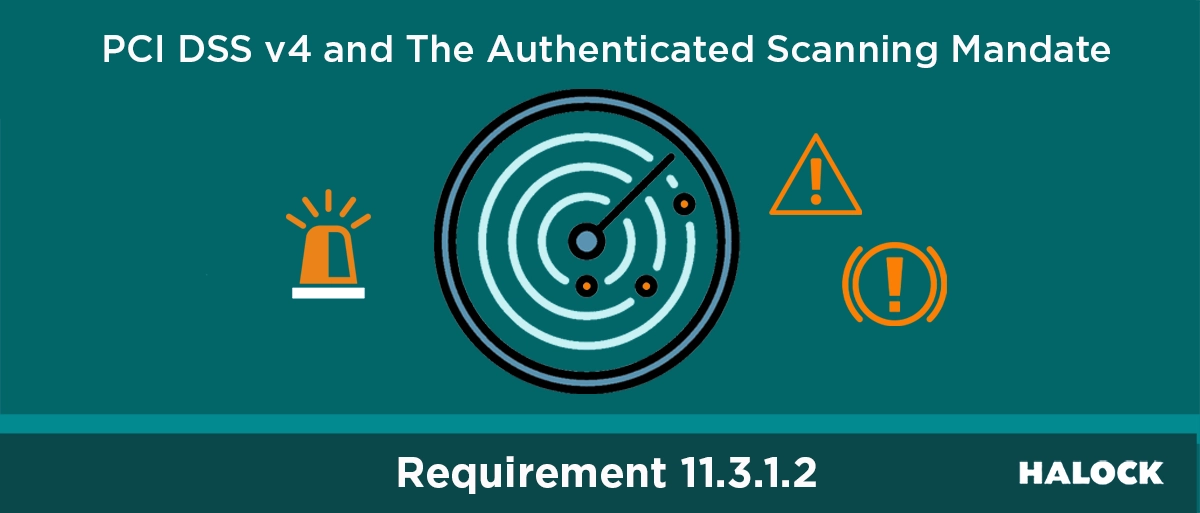Preparing for PCI DSS 4.0.1: The Authenticated Scanning Mandate
As organizations prepare for PCI DSS v4.0.1 enforcement on March 31, 2025, Requirement 11.3.1.2 introduces a critical update: the mandate for authenticated internal vulnerability scans. This new requirement addresses limitations in previous versions by requiring deeper, more accurate assessments of internal vulnerabilities.
What are the Key Points of Requirement 11.3.1.2?
- Authenticated Access: Internal scans must use privileged credentials.
- Credential-Based Scanning: Scanning tools must log into network resources and system components.
- Documentation of Exceptions: Systems unable to accept credentials must be documented and accounted for.
For a deeper understanding of how to meet PCI DSS requirements, visit HALOCK’s Compliance resource page.
What are the Advantages of Authenticated Scanning?
This requirement marks a significant advancement in vulnerability management. Authenticated scans provide deeper insights, mirroring the privileged access attackers seek to exploit.
- Deeper Visibility: Access to internal configurations and sensitive areas reveals vulnerabilities hidden from unauthenticated scans.
- Reduced False Positives: Privileged access reduces false alarms by distinguishing legitimate configurations from real risks.
- Better Risk Context: Authenticated scans prioritize remediation based on severity and exploitability.
- Application-Specific Insights: Detect issues like misconfigured authentication, insecure APIs, and weak encryption.
- Improved MFA Assessment: Identify weaknesses in rate limiting, lockout policies, and push notification handling, guarding against MFA fatigue attacks.
Vulnerabilities Revealed by Authenticated Scans
Authenticated scans uncover a broader range of risks, including:
- Configuration Errors: Weak encryption protocols, open ports, and insecure file permissions.
- Patch Gaps: Unpatched vulnerabilities or outdated software.
- Access Control Issues: Inactive accounts, excessive permissions, and poor privilege management.
- Authentication Flaws: Weak passwords, broken authentication flows, and ineffective session controls.
- System Exposure: Forgotten or unmanaged systems connected to production environments.
By mimicking legitimate user access, authenticated scans provide an accurate internal security assessment, identifying risks that unauthenticated scans might miss.
Lessons from Recent Breaches
Recent cybersecurity incidents demonstrate how vulnerabilities that could have been identified through authenticated scans can lead to significant breaches:
- The Uber Data Breach (2022): Attackers gained access to internal systems by leveraging stolen contractor credentials and exploiting hardcoded administrative passwords. Authenticated scans could have revealed poor credential management practices, such as unused accounts and excessive privileges.
- The 23andMe Credential Stuffing Attack (2023): Attackers bypassed weak rate limiting and lockout policies to compromise user accounts and expose sensitive data. Authenticated scans could have identified misconfigured authentication settings and insufficient safeguards against brute force attacks.
These breaches highlight how authenticated scans can uncover hidden vulnerabilities like weak access controls, poor password policies, and misconfigured systems—proactively addressing security risks before attackers exploit them.
How HALOCK Can Help
Navigating the new authenticated scanning requirements under PCI DSS v4.0.1 (Requirement 11.3.1.2) can be challenging, but HALOCK provides the expertise to help your organization prepare effectively. Our focus is on empowering your team to understand and meet the requirements while maintaining compliance. Here’s how we can support you:
- Guidance on Control Requirements: HALOCK helps you interpret the nuances of Requirement 11.3.1.2, ensuring your internal processes align with PCI DSS expectations for authenticated scanning.
- Clarifying Scope: We assist in defining which systems require authenticated scanning and how to document exceptions for those that cannot accommodate it.
- Best Practices for Compliance: HALOCK provides insights into how other organizations successfully implement authenticated scans, offering strategies to streamline compliance efforts.
- Audit Preparation: We help ensure your documentation, processes, and scanning results are audit-ready, addressing key questions that assessors are likely to ask.
- Support for Internal Teams: Whether your team is running scans or managing documentation, we offer expert advice to help navigate the complexities of PCI DSS compliance.
Ready to Meet the Challenge?
PCI DSS v4.0.1 introduces new challenges, but you don’t have to face them alone. Visit our PCI DSS services page or Contact HALOCK today to ensure your organization is prepared for compliance success.
By Viviana Wesley, PCI QSA, ISO 27001 Auditor, CISM – Principal Consultant, Governance, Compliance and Engineering Services and Jason Maiden, CISSP, PMP, PCI QSA, ISO 27001 Lead Auditor – Managing Consultant

